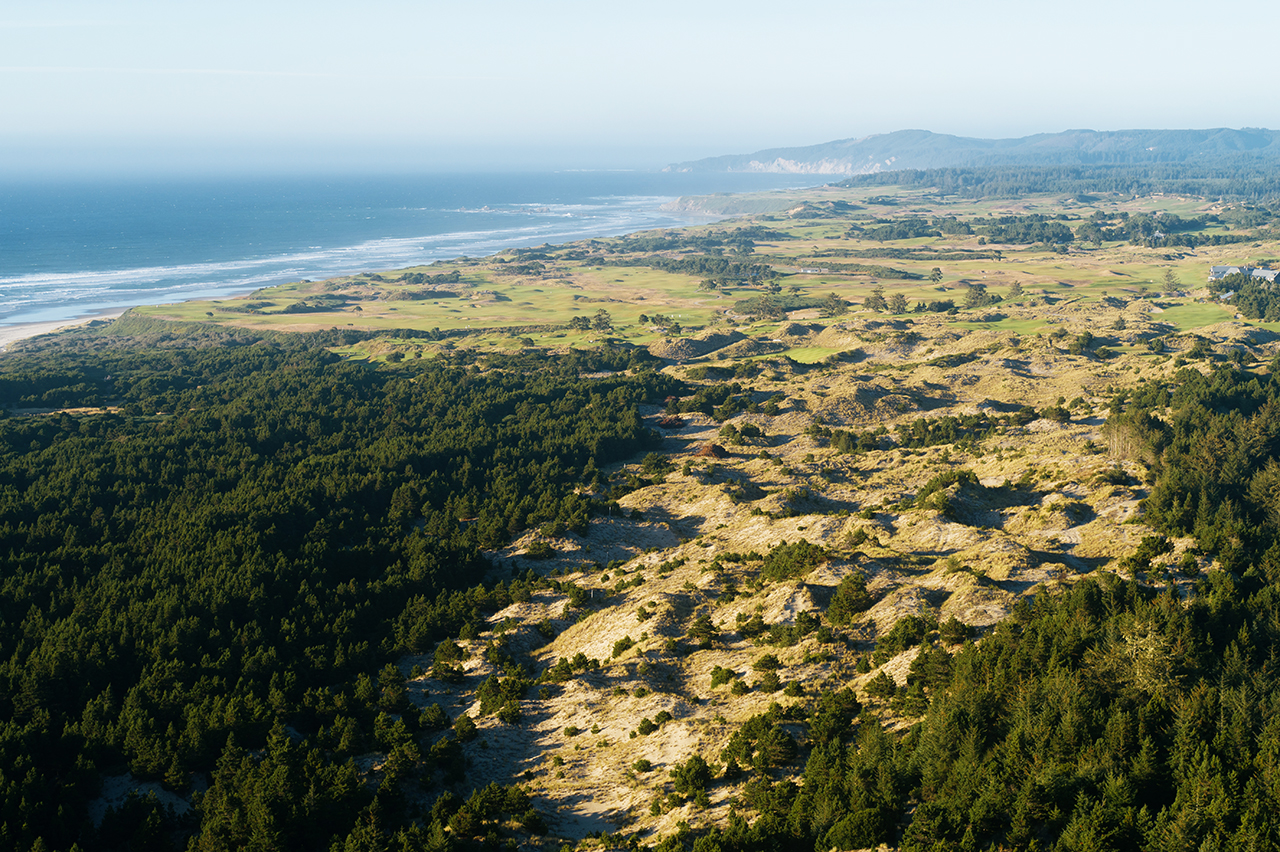Bandon Preserve, the 13-hole par-3 course that opened in 2012 at Bandon Dunes Golf Resort in Oregon, ushered in a trend of high-end resorts adding short courses that far exceed the experience of many afterthought par-3 layouts that came in preceding decades. Real holes on stunning terrain make for an unforgettable experience that has become a major draw along the southern Oregon coast, and a new breed of par-3 course has evolved around the world.
And Bandon Preserve will soon have a sibling just a few hundred yards south along the coastline.
The resort officially announces today that it is constructing a new, 19-hole par-3 course, yet to be named and built by the WAC Golf team of Rod Whitman, Dave Axland and Keith Cutten. The layout was routed on dunesland between the first hole of the resort’s Bandon Trails course and the Pacific Ocean, and construction is already underway. Plans are for the course to be completed this year, with some preview play possible this fall and a full opening in 2024.
The layout for Bandon Dunes Golf Resort’s new par-3 course between the first hole of Bandon Trails and the Pacific Ocean (Courtesy of Bandon Dunes Golf Resort)
“This is just an incredible piece of ground, and we’re super excited about it,” said Cutten, the youngest member of the WAC design team who has worked in various roles with Whitman and Axland for more than a decade, most notably at Cabot Links in Nova Scotia, one of the top-rated public-access courses in Canada. “It’s quite a bit choppier, more severe changes in the dunes than some of the other pieces of ground out there, so it’s just perfect for a short course.”
The layout of Bandon’s new par-3 course has been in consideration for years, and architect Tom Doak had marker flags in the ground for a proposed routing last year. Bandon Dunes founder and owner Mike Keiser said plans changed, and the WAC team was given a chance to create a layout on what Keiser always believed to be a special piece of land.
“We called and said, ‘Why don’t you stop by and see what you can do?’ ” Keiser said. “They came up with, I think, a brilliant routing. I wouldn’t call it short, because our scorecard will have short, medium and long distances. They did a fabulous job and you’ll have to wait and see for yourself.”
Holes will range from just under 60 yards up to nearly 160, depending on the tees selected, Cutten said. Keiser said the plan is for each of the 19 holes to offer a chance to tee off with a putter, at least from the forward tees.
The layout will consist of 16 acres of maintained turf across lumpy, bumpy and sandy dunes, into and out of various natural bowls and across ridges. Cutten said the terrain was perfect for a par-3 course because there was no need to design landing areas for tee shots on par 4s and 5s, allowing the design team to instead focus on finding the most interesting and natural green sites full of interesting bounces and rolls.
“I think all but one of our greens were basically just sitting there” on the ground already, Cutten said. “The one (that’s not) that I’m referring to, the 10th, needs a little bit of sand in the middle but the edges are already there, so it looks like it’s already there. The rest of the greens are just found.”
The original WAC routing was 12 holes, but Cullen said the team kept finding interesting green sites and possibilities for additional holes. They finally settled on 18, playing down toward the ocean then back up in a series of loops. Keiser then added a 19th hole.
“It was 18 holes, and I was just out there with my son Chris, and we decided the walk from 18 up to the clubhouse was too arduous,” Keiser said of the process with his son, who along with brother Michael operates Sand Valley resort in Wisconsin. “So we put in another par 3 as the 19th hole there to take us back up to the great clubhouse site.”
Keiser said his one mandate is that each hole can stand on its own and would fit well on any of the resort’s five 18-hole layouts that rank among the best modern courses in the world. Cutten said that was no problem on terrain so naturally suited to golf.
Keith Cutten (from left), Dave Axland, Rod Whitman, Chris Keiser and Mike Keiser at the site of the new par-3 course at Bandon Dunes Golf Resort in Oregon (Courtesy of Bandon Dunes Golf Resort)
“It became a running joke as we toured Mr. Keiser around that we should be paying him for the golf course, because all the work was already done,” Cutten said. “It speaks well to the quality of the ground and the kind of golf we were able to put on it. …
“On a short course, you can get a little more bold with the decisions you’re making and the contours you’re using. A lot of the times the short courses can be a little more funky and dynamic and quirky, a lot of the things we try to do with our golf courses from the get-go.”
Keiser said he isn’t sure yet what that clubhouse will look like, possibly a “glorified mobile home.” Don’t be surprised if he decides to include some sort of food truck, a version of which has proved incredibly popular at Sand Valley’s par-3 course named the Sandbox.
Keiser anticipates the new course, which will raise the total number of par 3s at Bandon Dunes Golf Resort to 53, will complement the Preserve, designed by the team of Bill Coore and Ben Crenshaw. The resort is also home to Shorty’s, a nine-hole par-3 course at the practice facility that is open only at select times.
“I think most people who have time will play both of them,” he said. “We’ll have to wait to see which they favor, but Preserve is awfully good, as is this new one.”
Keiser said that like the Preserve, the green fee will be $100, with all proceeds benefiting the Wild Rivers Coast Alliance to support communities along the southern coast of Oregon. The resort has contributed $7.3 million to the WRCA, with the Preserve now generating $800,000 a year for the charity.








